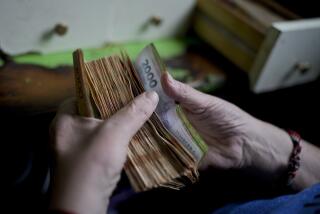Turkish Currency Is One in a Million
- Share via
ISTANBUL, Turkey — Starting today, Turks will no longer have to shell out millions to buy a stick of chewing gum. Tourists will no longer have to squint at the bills they receive, trying to count the zeros that fill a price tag or a piece of money.
Turkey is launching a new currency, the New Turkish Lira, or YTL, that drops six zeros, makes the money more manageable and, the government hopes, gives a psychological boost to citizens, business owners and investors.
One million liras abruptly becomes 1 lira, about 65 cents. A 20-million lira bill -- until now the country’s largest denomination -- becomes 20 lira, or roughly $13.
“With the YTL, our currency’s longing for prestige is coming to an end,” Turkish Prime Minister Recep Tayyip Erdogan said at ceremony to unveil the new banknotes.
Turkish officials see the new currency as another crucial step in Turkey’s quest for membership in the European Union and the wider Western world.
It has been difficult to take the currency seriously. Where else do you spend 4 million for a coffee? And the poorest Turk can easily be a millionaire, earning a pittance by begging, picking up trash or selling nuts on the street. A pittance of millions.
“This will be a good thing,” said Tahir Eginci, who sells hand-painted ceramics in Istanbul’s Grand Bazaar. “So many zeros, it scares customers. They ask a lot of questions and are very nervous.” He said that there had been such a lack of confidence in the national money that his Turkish landlords wanted the rent for his home and two storefronts paid in foreign currencies such as euros or dollars.
The Turkey’s inflated currency has long been a symbol of national shame, reminding Turks of three decades of hyperinflation and economic disaster. Inflation surpassed 100% in the mid-1990s, and in 2002, Turkey plunged into its worst recession since World War II.
An International Monetary Fund package, including a $16-billion loan, rescued the economy two years ago. As part of its end of the deal, the Turkish government enacted economic reforms that stabilized the banking system, battled inflation and boosted growth.
Annual inflation today, despite the occasional monthly uptick, stands at about 9% or 10%. Turkey is on track this year for its lowest inflation rate in nearly 30 years.
The Central Bank, which oversees currency and macroeconomic matters, has been removed from the control of political parties, making it far more efficient, economists say.
With years of hyperinflation presumably behind them, Turks can afford the change in their money. Authorities have plastered posters around Istanbul and Ankara, the capital, to promote the new banknotes, and the government has asked imams to spread the word in their mosques.
“It is already clear that the Turkish people, hungry for stability after years of inflation, will adapt easily to the YTL,” Economy Minister Ali Babacan said.
“This proves that the country is on an irreversible road of economic progress and our nightmares are behind us,” he said. “Our people’s confidence in their national currency will be restored.”
Polls, however, have shown some nervousness. Small-business owners have complained about the costs of refitting cash registers and tax-receipt machines, and many consumers worry that the new currency will have an inflationary effect. When European nations introduced the euro a few years ago, some merchants rounded prices up, raising the cost of basic goods.
And the logistics of distributing the new bills will be difficult.
“There’s bound to be confusion at first, especially among older people,” said Salih Bitmez, a grocer in Ankara. “We’ve had our cash register readjusted to the new lira but it’s going to take a while getting used to, not just for customers but for us as well.”
Higher-denomination notes have been issued, including 50 and 100 YTLs. Like other bills, they will bear a portrait of Mustafa Kemal Ataturk, the founder of modern Turkey. Authorities will again mint coins, called kurus, 100 of which equal a new Turkish lira.
“I think it’s great because finally I’ll be able to fit my money into my wallet,” said Ankara resident Birgul Onen. “No more having to carry around unwieldy stacks of old bills, even to buy a few potatoes and onions.”
The prices of goods and services will be listed in the old and new currency during the transition, similar to what Europeans did when switching from local currencies to the euro. Turks and visitors may continue to use the old notes through this year, as it gradually is phased out.
Wilkinson was recently on assignment in Istanbul. Special correspondent Amberin Zaman contributed from Ankara.
More to Read
Sign up for Essential California
The most important California stories and recommendations in your inbox every morning.
You may occasionally receive promotional content from the Los Angeles Times.














